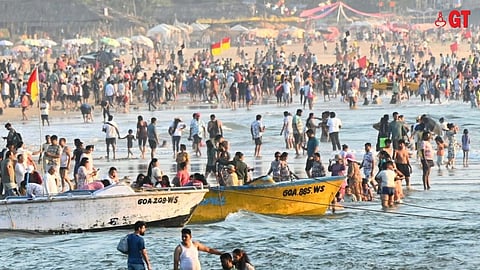

In the din of the brouhaha over Goa’s tourist numbers during its last New Year festive season, one thing rang out loud – it was the changing image of Goa.
The panoramic image of sun-drenched, white-sand beaches – littered with shacks and edged with rolling palms – has given way to beaches packed with tourists, the sea speckled with revellers on water skis towed along with water-scooters, and the sky dotted with paragliders.
This change in the State’s image is also translating into the change in the profile of tourists. As Goa is reinventing itself, it is attracting a different kind of tourist.
This phenomenon was taking place gradually, but surely, about a decade back. Post COVID-19, its pace has hastened and become starkly noticeable.
So, Goa is no longer only about sun, sand and sea. It now mixes watersports, trekking in the hills and wilderness, heritage walks, experiential tours and a lot more.
These offerings have different kinds of takers and have changed the Goan experience. It’s no longer about booking into a hotel room and relishing a tranquil walk with a beer or a cocktail and shack food on the beach.
Or, just riding on a scooter or a bike through the coconut-palm-lined serpentine streets, or rejuvenating in a spa. It was where visitors found their mojo or mental peace in the slow and rhythmic pace of life at hotels and resorts.
Time was when foreign tourists lounging on sunbeds on the beach most commonly typified Goa. That picture is fraying, and fading in the memories of today’s tourists.
The most common image of the new Goa emerging is of hordes of unruly youth enjoying their booze on the beach. They descend in large numbers on the State in mini buses, jeeps or cars.
They crowd the popular North Goan beaches of Calangute, Candolim, Baga, Vagator and others, leaving behind telltales of their revellery in empty liquor bottles, plastic water bottles and food wrappers.
The local authorities are at their wit’s end how to tackle the issue. The pressure on their limited resources has suddenly shot up without a proportionate jump in their income from tourists.
These young visitors, who come to Goa mainly to get sloshed and party, are mostly not big spenders. They prefer to spend less on lodging and food.
A large part of their travel budget constitutes liquor costs, which generates revenue for the State government.
The other face of the new visitor is the family, which comes to the State to spend quality time with their close ones. They are not as thrifty as the former, but they regulate their expenses to check them from spiralling.
This group of tourists chooses Goa to have a frolicking time. This means zipping around on water scooters or water skis, dipping their feet or swimming in the sea, paragliding over the sea and hills of Goa, whitewater river rafting, building sand castles and other such activities.
This has seen operators of water sports and other commercial activities spring up around tourist places in Goa, to the extent that they are now over-commercialised. This is stripping away the charm of many of these places.
If the government does not address this, the waning charm of tourist hotspots could adversely impact tourism.
Invariably, tourism stakeholders complain about the rising menace of touts on the beaches and other places, which is not only denting the image of Goa, but is also seen as a nuisance by tourists.
The third category of travellers to Goa consists of high-net-worth-and-discerning tourists. This breed has been exposed to high quality of tourism across the globe or at least, the Southeast Asia.
It comes to Goa because of its proximity and because it is hassle-free – no visa, immigration formalities and other such niggles. This band of visitors is small in number, but spends big. Not long ago, they patronised Goa as their go-to holiday, or leisure, destination.
Increasingly, this group is getting disillusioned with the altering image of Goa. It’s not seeing value in spending its dollar on the Goa that is emerging.
It could be this group of travellers, whose numbers may have fallen. Since they constitute a small proportion of the total number of tourists arriving into the State, they are not clearly reflected in the drop in tourist numbers.
However, as they contribute significantly to the State’s tourism revenue, their departure will leave a hole.
It would be in the economic interests of the State government to pursue a balanced tourism policy, which pulls in all classes or types of tourists.
It also has to watch out not to overindulge in the numbers game and drive out the cash cows, who have been sustaining its tourism economy.